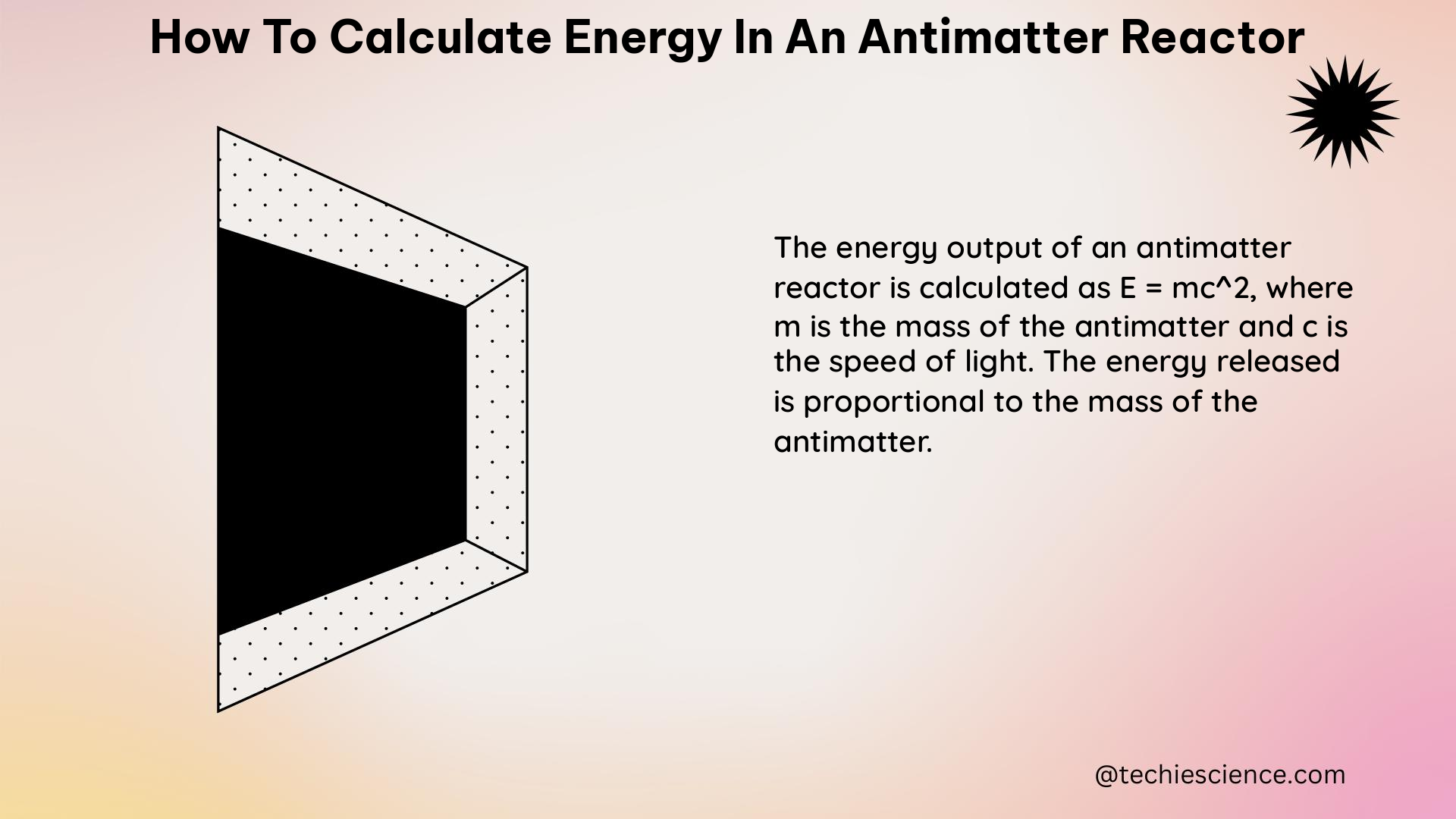Calculating the energy in an antimatter reactor involves using the formula for relativistic energy, which takes into account the rest mass of the object, the speed of light, and the Lorentz factor. This comprehensive guide will provide you with the necessary theoretical background, formulas, examples, and numerical problems to help you master the calculation of energy in an antimatter reactor.
Understanding Relativistic Energy
The formula for relativistic energy is given by:
E = γmc²
Where:
– E is the total energy of the object
– γ (gamma) is the Lorentz factor
– m is the rest mass of the object
– c is the speed of light
The Lorentz factor is calculated using the formula:
γ = 1/√(1 – v²/c²)
Where:
– v is the velocity of the object
Example: Calculating Energy Released from Antimatter-Matter Annihilation
Let’s calculate the energy released when 1 kg of antimatter annihilates with 1 kg of matter. The total mass m that gets converted into energy is 2 kg (since both matter and antimatter contribute to the energy release). The speed of light c is a constant at approximately 3 x 10^8 meters/second.
Using these values, we can calculate the energy E released from the annihilation as:
E = 2 kg x (3 x 10^8 m/s)^2
E = 1.8 x 10^18 Joules
This is equivalent to the energy released by approximately 43 million tons of TNT, or about 860 Tsar Bomba nuclear weapons.
Comparison to Nuclear Reactions
It’s important to note that the energy released from antimatter-matter annihilation is much higher than that of conventional nuclear reactions. This is because antimatter annihilation converts 100% of the mass into energy, while nuclear reactions typically convert only a small fraction of the mass into energy.
Calculating Kinetic Energy of Relativistic Objects

To calculate the kinetic energy of a relativistic object, we can use the formula:
E = γmc² – mc²
Where:
– E is the kinetic energy
– m is the rest mass of the object
– c is the speed of light
– γ is the Lorentz factor
Example: Kinetic Energy of a Proton in a Van de Graaff Accelerator
Let’s calculate the kinetic energy of a proton accelerated by a potential difference of 50.0 MV (mega-volts) in a Van de Graaff accelerator. The rest mass energy of a proton is approximately 938.3 MeV (mega-electron volts).
Using these values, we can calculate the Lorentz factor γ as:
γ = 1 + (E/mc²)
γ = 1 + (50.0 x 10^6 eV / 938.3 x 10^6 eV)
γ = 1.052
We can then calculate the kinetic energy E of the proton as:
E = γmc² – mc²
E = 1.052 x 938.3 x 10^6 eV – 938.3 x 10^6 eV
E = 52.1 x 10^6 eV
This is equivalent to approximately 52.1 mega-electron volts (MeV).
Technical Specifications of an Antimatter Reactor
An antimatter reactor would need to be able to store and control large amounts of antimatter, as well as manage the high energy output. This would require advanced technologies such as:
- Magnetic confinement: Powerful magnetic fields to contain and control the antimatter particles.
- Superconducting magnets: High-strength magnets made of superconducting materials to generate the necessary magnetic fields.
- High-energy particle detectors: Sophisticated detectors to monitor and measure the antimatter particles and the energy released during annihilation.
Numerical Problems
- Calculate the energy released when 10 grams of antimatter annihilates with 10 grams of matter.
- A proton is accelerated to a velocity of 0.9c in a particle accelerator. Calculate the kinetic energy of the proton, given that the rest mass energy of a proton is 938.3 MeV.
- An antimatter reactor is designed to produce 1 GW of power. Assuming 100% conversion efficiency, calculate the amount of antimatter required per second to sustain this power output.
Conclusion
Calculating the energy in an antimatter reactor involves the use of relativistic energy formulas, which take into account the rest mass of the object, the speed of light, and the Lorentz factor. By understanding these concepts and applying the relevant equations, you can accurately determine the energy released during antimatter-matter annihilation and the kinetic energy of relativistic objects. The technical specifications of an antimatter reactor, such as magnetic confinement and high-energy particle detectors, are also crucial considerations in the design and operation of such a system.
References
- Antimatter – an overview | ScienceDirect Topics: https://www.sciencedirect.com/topics/earth-and-planetary-sciences/antimatter
- 28.6 Relativistic Energy – College Physics – UCF Pressbooks: https://pressbooks.online.ucf.edu/phy2053bc/chapter/relativistic-energy/
- Relativistic Energy | Physics – Lumen Learning: https://courses.lumenlearning.com/suny-physics/chapter/28-6-relativistic-energy/

The lambdageeks.com Core SME Team is a group of experienced subject matter experts from diverse scientific and technical fields including Physics, Chemistry, Technology,Electronics & Electrical Engineering, Automotive, Mechanical Engineering. Our team collaborates to create high-quality, well-researched articles on a wide range of science and technology topics for the lambdageeks.com website.
All Our Senior SME are having more than 7 Years of experience in the respective fields . They are either Working Industry Professionals or assocaited With different Universities. Refer Our Authors Page to get to know About our Core SMEs.